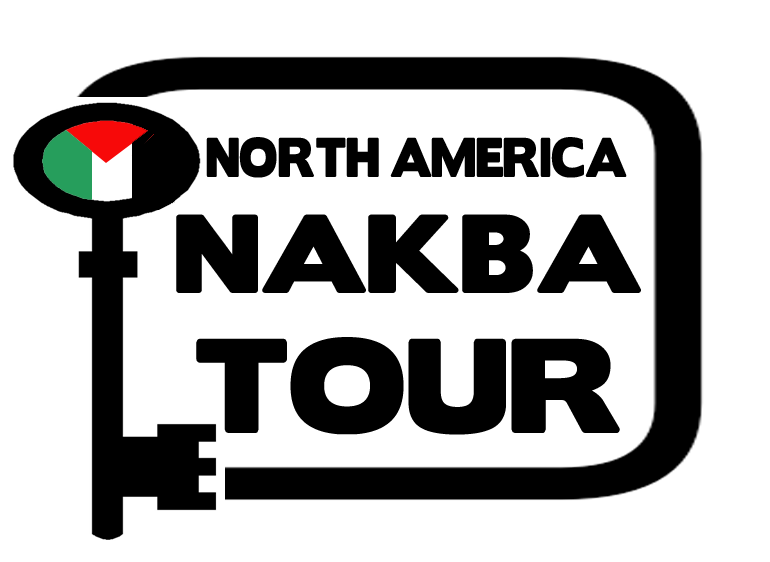What is the Nakba? | What happened to Palestinian refugees? | Palestinian refugees in Lebanon today |
Further Resources
In 1948, the nascent State of Israel expelled upwards of 750,000 indigenous Palestinians from their homeland to create a Jewish state. These individuals and their descendants today live in exile: in refugee camps, in Gaza, the West Bank, and other neighboring countries. This event is commemorated by Palestinians as “the Nakba,” or Catastrophe. Below are some basic resources on Nakba.
What is the Nakba?
In 1947-1949, over 750,000 indigenous Palestinians were driven from their homes, towns and lands by well-armed Zionist militias. The term Nakba, which means “catastrophe” in Arabic, refers to this mass expulsion, a catastrophe for the Palestinian people that continues to the present day.
The Nakba was not accidental or unintended; instead, it was a systematic, deliberate act of ethnic cleansing designed to produce a Jewish majority state in Palestine. In order to produce this result, the forced expulsion of the vast majority of the Palestinian population – the indigenous Arab people of all religions – was a necessity.
There were over 450 Palestinian cities and towns that were destroyed and depopulated by Zionist militias between 1948 and 1950, three-quarters of the Palestinian villages inside the areas occupied by Zionist forces. Over 4 million acres of land were expropriated by the Israeli state from Palestinian peasants and landholders; 78 percent of historic Palestine was occupied.
The vast majority of Palestinian refugees were forced into the remaining 22 percent of Palestine, especially in the West Bank and the Gaza Strip; to Lebanon, Jordan, Syria and Egypt; and internally displaced inside occupied Palestine ‘48.
What happened to Palestinian refugees?
While Palestinian refugees forced from their homes and lands lived in makeshift camps with only tents and minimal aid to provide protection, the newly declared Israeli state enacted a series of laws designed to seize their property and prevent their return: The Absentee Property Law, the Law of Return, and the Entry into Israel Law.
Meanwhile, the right of the Palestinian refugees to return was recognized by the United Nations in General Assembly Resolution 194, a right already upheld in the Universal Declaration of Human Rights. Despite the fact that even Israel’s admission to the United Nations referred back to the refugees’ return, Palestinians seeking to return to their land were labeled “infiltrators,” facing death or imprisonment for attempting to return to the homes from which they were displaced.
Nonetheless, for nearly 70 years, the Israeli state has completely refused to implement Palestinian refugees’ right of return for the sole reason that they are of an unwelcome ethnicity and religious identity on their own land.
Today, according to statistics by Palestinian NGOs and the United Nations, there are over 7 million Palestinian refugees around the world. One of the largest groups of Palestinian refugees is on the border of Palestine – in Lebanon.
Palestinian refugees in Lebanon today
There are 12 recognized Palestinian refugee camps in Lebanon today, where over half of the 450,000 registered Palestinian refugees in Lebanon live. Still denied their right to return to Palestine for over 70 years, Palestinian refugees in Lebanon are struggling for a decent life and their human and civil rights in Lebanon as part of their struggle to return to Palestine and seek the liberation of their occupied land.
There are over 36 banned professions for Palestinian refugees in Lebanon. Even if a Palestinian refugee obtains an education in law, medicine, engineering or pharmacy, they cannot work in their chosen profession – or even in public transportation or farming.
In order to work at all, Palestinian refugees in Lebanon must obtain an annual permit; the process is bureaucratic, difficult and employer-dependent, forcing refugees into unemployment or black-market work.

Infographic by Visualizing Palestine
56 percent of Palestinian refugees in Lebanon are unemployed and over two-thirds are considered to be living in poverty or extreme poverty. Furthermore, Palestinian refugees cannot own land and property. Inside the camps, electricity and water shortages are common, while makeshift wiring is run from building to building with few safeguards.

Infographic by Visualizing Palestine
While Palestinian refugee camps in Lebanon were once the center of the Palestinian revolution to which socially conscious people around the world came to be part of the Palestinian struggle, following the 1993 Oslo Accords or the so-called “peace process” in Palestine, Palestinian refugees in Lebanon have only become more marginalized.
In this situation, Palestinians continue to be displaced as many Palestinian youth are forced to seek asylum abroad in order to support their families – part of the ongoing Nakba.
Further Resources
Videos
A short history of the Nakba.
Al-Nakba, Part one of an award-winning four-part documentary on the Nakba.
Online Summaries
The Catastrophe: Al Nakba, How Palestine became Israel. A short summary of the history of the Nakba. Source: If Americans Knew.
The Nakba: 65 Years of Dispossession and Apartheid. A detailed resource on the Nakba. Source: Institute for Middle East Understanding.
The Arab Villages lost since Israel’s war of independence. An interactive map documenting the destruction of Palestinian villages. Source: The Guardian
Further Reading
Salman Abu-Sita, Palestine Right of Return: Sacred, Legal, and Possible.
Ghada Karmi, In Search of Fatima: A Palestinian Story
Ilan Pappe, The Ethnic Cleansing of Palestine
Nur Masalha, Expulsion of the Palestinians
Mazin Qumsiyeh, Sharing the Land of Canaan
Shlomo Sand, The Invention of the Jewish People
Gabriel Piterberg, The Returns of Zionism: Myths, Politics, and Scholarship

